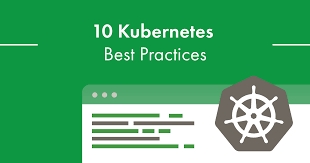Top 10 Common DevOps/SRE Interview Questions and Answers on Kubernetes Best Practices

How Do You Set Resource Requests and Limits in Kubernetes?
Resource requests ensure a minimum amount of resources (CPU/Memory) for a container, while limits enforce the maximum resources a container can consume. This helps with efficient resource allocation and prevents resource contention.
Example:
resources:
requests:
memory: "256Mi"
cpu: "500m"
limits:
memory: "512Mi"
cpu: "1000m2. Why is Namespace Important in Kubernetes?
Namespaces allow you to partition a single Kubernetes cluster into multiple virtual clusters, providing isolation between different teams or projects. They are useful for managing resource quotas and policies.
Example:
kubectl create namespace dev3. How Do You Ensure High Availability in Kubernetes?
Use multi-zone clusters with redundant control plane components. Distribute workloads across multiple nodes and regions, ensuring no single point of failure.
Example:
Deploy an application using a
Deploymentwithreplicasspread across nodes
replicas: 34. What Are the Best Practices for Kubernetes Networking?
Use network policies to control pod communication and secure the network.
Implement service mesh (e.g., Istio) for better traffic management and observability.
Example of a NetworkPolicy:
apiVersion: networking.k8s.io/v1
kind: NetworkPolicy
metadata:
name: allow-only-app
spec:
podSelector:
matchLabels:
app: myapp
policyTypes:
- Ingress
ingress:
- from:
- podSelector:
matchLabels:
app: frontend5. How Can You Secure Secrets in Kubernetes?
Avoid storing sensitive information in plain text within configurations. Use Kubernetes Secrets to manage credentials, API keys, and other confidential data.
Example:
kubectl create secret generic db-user-pass --from-literal=username=myuser --from-literal=password=mypassword6. What Are the Best Practices for Rolling Updates in Kubernetes?
Use the RollingUpdate strategy in Deployments to minimize downtime. This allows updating the application gradually while keeping it available.
Example:
strategy:
type: RollingUpdate
rollingUpdate:
maxUnavailable: 1
maxSurge: 17. How Do You Handle Application Scaling in Kubernetes?
Use the Horizontal Pod Autoscaler (HPA) to automatically scale your application based on CPU, memory, or custom metrics.
Example:
kubectl autoscale deployment myapp --cpu-percent=50 --min=1 --max=108. What Are the Best Practices for Kubernetes Logging and Monitoring?
Centralize logs using logging tools like Fluentd or ELK stack.
Use Prometheus and Grafana for monitoring cluster performance and setting alerts.
9. How Can You Optimize Kubernetes Storage?
Use Persistent Volumes (PV) and Persistent Volume Claims (PVC) to decouple storage from pods. Ensure storage scalability and availability.
Example:
apiVersion: v1
kind: PersistentVolumeClaim
metadata:
name: my-pvc
spec:
accessModes:
- ReadWriteOnce
resources:
requests:
storage: 1Gi10. Why Should You Use Liveness and Readiness Probes?
Liveness probes help ensure a container is still running, while readiness probes check if the container is ready to serve traffic. Both are essential for self-healing and proper traffic routing in Kubernetes.
Example:
livenessProbe:
httpGet:
path: /healthz
port: 8080
initialDelaySeconds: 3
periodSeconds: 3readinessProbe:
httpGet:
path: /ready
port: 8080
initialDelaySeconds: 5
periodSeconds: 5Conclusion
Mastering Kubernetes best practices is crucial for DevOps and SRE professionals to ensure the efficiency, scalability, and security of containerized applications. By understanding resource management, networking, security, and scaling strategies, you can manage Kubernetes clusters more effectively and ensure your applications run smoothly in production environments. Whether you’re preparing for an interview or refining your Kubernetes skills, following these best practices will help you build and maintain robust, high-performing systems.
Thank you for reading!🙏 If you enjoyed this article and want to stay updated with more content like this, follow me on my social media channels:
YouTube: Techwithpatil
LinkedIn: Tech with Patil
Instagram: techwithpatil
Feel free to connect, and let’s continue the conversation!😊
🚀 Struggling with Kubernetes Concepts? We’ve Got You Covered!
This course simplifies everything with: ✅ Real-world examples to connect theory with practice. 🛠️ Hands-on labs to build confidence through action. 📚 Clear explanations that make even complex topics easy to understand.
👉 You won’t find a better way to master Kubernetes! Enroll Now https://cloudops0.gumroad.com/l/k8s
and take the first step toward becoming a Kubernetes pro! 🌟
MicroservicesContainerizationDockerKubernetesSite Reliability Engineer
Last updated